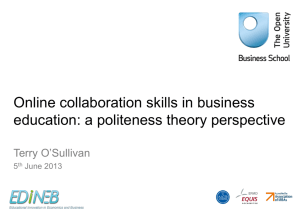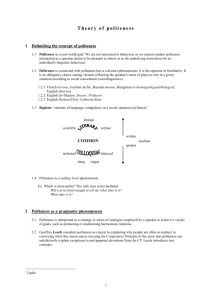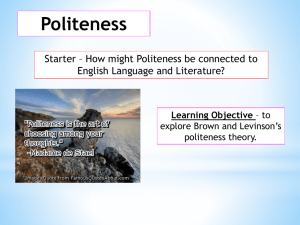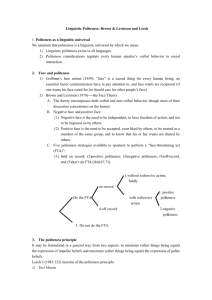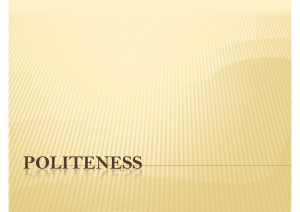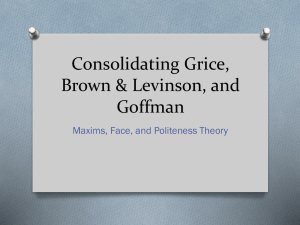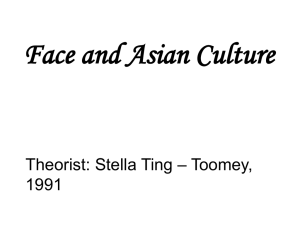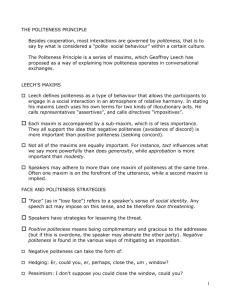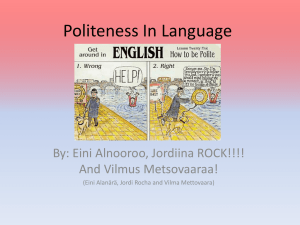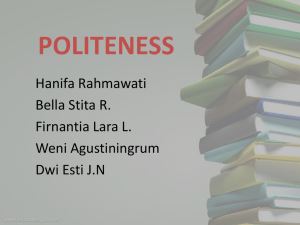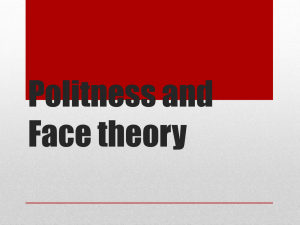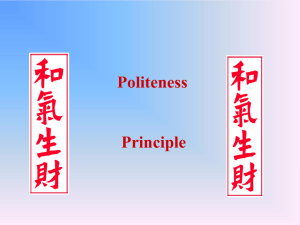The Politeness Principle - Universitatea "1 Decembrie 1918"
advertisement
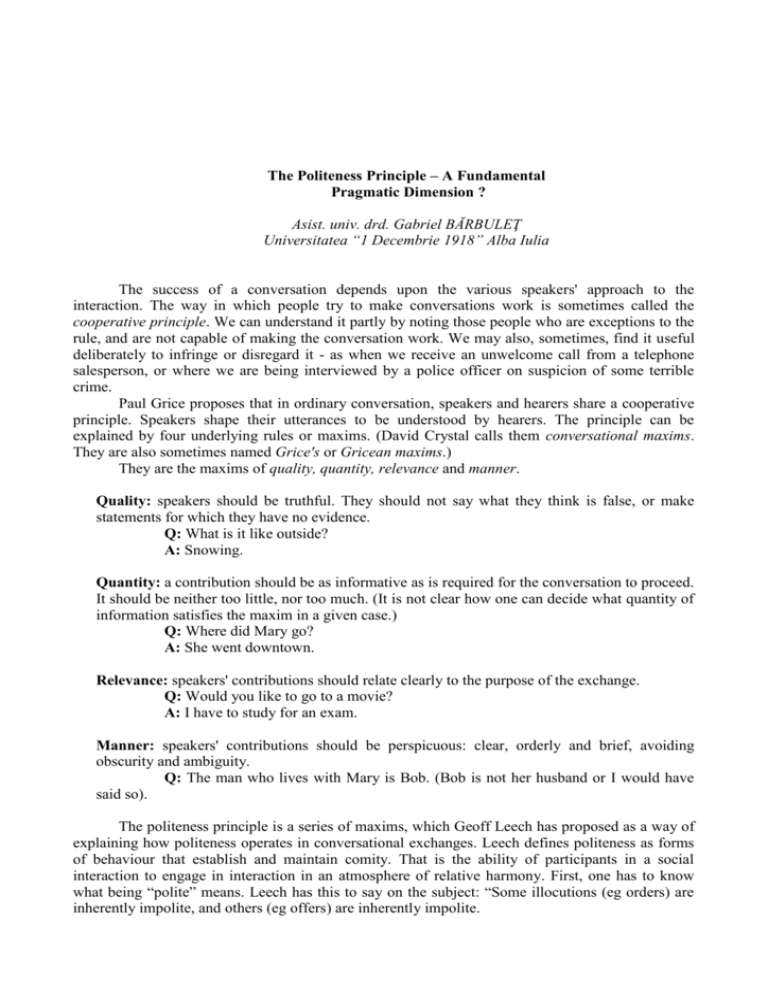
The Politeness Principle – A Fundamental Pragmatic Dimension ? Asist. univ. drd. Gabriel BĂRBULEŢ Universitatea “1 Decembrie 1918” Alba Iulia The success of a conversation depends upon the various speakers' approach to the interaction. The way in which people try to make conversations work is sometimes called the cooperative principle. We can understand it partly by noting those people who are exceptions to the rule, and are not capable of making the conversation work. We may also, sometimes, find it useful deliberately to infringe or disregard it - as when we receive an unwelcome call from a telephone salesperson, or where we are being interviewed by a police officer on suspicion of some terrible crime. Paul Grice proposes that in ordinary conversation, speakers and hearers share a cooperative principle. Speakers shape their utterances to be understood by hearers. The principle can be explained by four underlying rules or maxims. (David Crystal calls them conversational maxims. They are also sometimes named Grice's or Gricean maxims.) They are the maxims of quality, quantity, relevance and manner. Quality: speakers should be truthful. They should not say what they think is false, or make statements for which they have no evidence. Q: What is it like outside? A: Snowing. Quantity: a contribution should be as informative as is required for the conversation to proceed. It should be neither too little, nor too much. (It is not clear how one can decide what quantity of information satisfies the maxim in a given case.) Q: Where did Mary go? A: She went downtown. Relevance: speakers' contributions should relate clearly to the purpose of the exchange. Q: Would you like to go to a movie? A: I have to study for an exam. Manner: speakers' contributions should be perspicuous: clear, orderly and brief, avoiding obscurity and ambiguity. Q: The man who lives with Mary is Bob. (Bob is not her husband or I would have said so). The politeness principle is a series of maxims, which Geoff Leech has proposed as a way of explaining how politeness operates in conversational exchanges. Leech defines politeness as forms of behaviour that establish and maintain comity. That is the ability of participants in a social interaction to engage in interaction in an atmosphere of relative harmony. First, one has to know what being “polite” means. Leech has this to say on the subject: “Some illocutions (eg orders) are inherently impolite, and others (eg offers) are inherently impolite. The point of politeness as a principle, is to minimize the effects of impolite statements and to maximize the politeness of polite illocutions. Here are some examples all provided by Leech: Parent: Someone’s eaten the icing off the cake. Child: It wasn’t ME! Leech’s point, in providing this example, is that this parent’s particular way of insinuating a possible misdemeanor commited by the child is considered more polite than something like this: “you have eaten the icing off the cake!” Thus the parent’s utterance while violating the maxim of quantity under the Cooperative Principle, inasmuch as it is not as informative as possible, or maybe not even relevant at all, obeys the principle of politeness. Further on, we shall try to deal with Leech’s maxims, trying to give a systematic approach. Leech's maxims Tact maxim: minimise cost to other; [maximise benefit to other] Generosity maxim : minimise benefit to self; [maximise cost to self] Approbation maxim : minimise dispraise of other; [maximise praise of other] Modesty maxim : minimise praise of self; [maximise dispraise of self] Agreement maxim: minimise disagreement between self and other; [maximise agreement between self and other] Sympathy maxim: minimise antipathy between self and other; [maximise sympathy between self and other] Face and politeness strategies “Face” (as in “lose face”) refers to a speaker's sense of linguistic and social identity. Any speech act may impose on this sense, and is therefore face threatening. And speakers have strategies for lessening the threat. Positive politeness means being complimentary and gracious to the addressee (but if this is overdone, the speaker may alienate the other party). Negative politeness is found in ways of mitigating the imposition: Hedging: Er, could you, er, perhaps, close the, um , window? Pessimism: I don't suppose you could close the window, could you? Indicating deference: Excuse me, sir, would you mind if I asked you to close the window? Apologizing: I'm terribly sorry to put you out, but could you close the window? Impersonalizing: The management requires all windows to be closed. In addition to the way G. Leech presents his maxims, perhaps the most thorough treatment of the concept of politeness is that of Penelope Brown and Stephen Levinson, which was first published in 1978 and then reissued, with a long introduction, in 1987. In their model, politeness is defined as redressive action taken to counter-balance the disruptive effect of face-threatening acts (FTAs). In their theory, communication is seen as potentially dangerous and antagonistic. A strength of their approach over that of Geoff Leech is that they explain politeness by deriving it from more fundamental notions of what it is to be a human being. The basic notion of their model is “face”. This is defined as “the public self-image that every member (of society) wants to claim for himself”. In their framework, face consists of two related aspects. One is negative face, or the rights to territories, freedom of action and freedom from imposition - wanting your actions not to be constrained or inhibited by others. The other is positive face, the positive consistent self-image that people have and their desire to be appreciated and approved of by at least some other people. The rational actions people take to preserve both kinds of face, for themselves and the people they interact with, add up to politeness. Brown and Levinson also argue that in human communication, either spoken or written, people tend to maintain one another's face continuously. In everyday conversation, we adapt our conversation to different situations. Among friends we take liberties or say things that would seem discourteous among strangers. And we avoid overformality with friends. In both situations we try to avoid making the hearer embarrassed or uncomfortable. Face-threatening acts (FTAs) are acts that infringe on the hearers' need to maintain his/her self-esteem, and be respected. Politeness strategies are developed for the main purpose of dealing with these FTAs. Suppose I see a crate of beer in my neighbour's house. Being thirsty, I might say: I want some beer. Is it OK for me to have a beer? I hope it's not too forward, but would it be possible for me to have a beer? It's so hot. It makes you really thirsty. Brown and Levinson sum up human politeness behaviour in four strategies, which correspond to these examples: bald on record, negative politeness, positive politeness, and offrecord-indirect strategy (examples from Brown and Levinson's politeness strategies). The bald on-record strategy does nothing to minimize threats to the hearer's “face”. An emergency: Help! Task oriented: Give me those! Request: Put your jacket away. Alerting: Turn your lights on! (while driving) The positive politeness strategy shows you recognize that your hearer has a desire to be respected. It also confirms that the relationship is friendly and expresses group reciprocity. Attend to the hearer: You must be hungry, it's a long time since breakfast. How about some lunch? Avoid disagreement: A: What is she, small? B: Yes, yes, she's small, smallish, um, not really small but certainly not very big. Assume agreement: So when are you coming to see us? Hedge opinion: You really should sort of try harder. The negative politeness strategy also recognizes the hearer's face. But it also recognizes that you are in some way imposing on them. Some other examples would be to say, “I don't want to bother you but...” or “I was wondering if...” Be indirect: I'm looking for a pen. Request forgiveness: You must forgive me but.... Minimize imposition: I just want to ask you if I could use your computer? Pluralize the person responsible: We forgot to tell you that you needed to by your plane ticket by yesterday. Off-record indirect strategies take some of the pressure off of you. You are trying to avoid the direct FTA of asking for a beer. Instead you would rather it be offered to you once your hearer sees that you want one. Give hints: It's a bit cold in here. Be vague: Perhaps someone should have been more responsible. Be sarcastic, or joking: Yeah, he's a real Einstein (rocket scientist, Stephen Hawking, genius and so on)! These strategies are not universal - they are used more or less frequently in other cultures. For example, in some eastern societies the off-record-indirect strategy will place on your hearer a social obligation to give you anything you admire. So speakers learn not to express admiration for expensive and valuable things in homes that they visit. Bibliography Fodor, Jerry A., 1975, The Language of Thought, Harvard University Press. Frege, Gottlob, [1892] 1952Grice, H. P., (1975), "Logic and Conversation", in P. Cole and J. Morgan, eds., Syntax and Semantics, vol. 3, Academic Press Grice, H.P., (1982), "Meaning Revisited", in N. V. Smith, ed., Mutual Knowledge, Academic Press Grice, H.P. (1989) Studies in the Way of Words, Harvard University Press Leech, G.N (1983) Principles of Pragmatics, Longman Levinson, S. (1983) Pragmatics, Cambridge University Press Levinson, S. (2000) Presumptive Meanings: The Theory of Generalized Conversational Implicature, MIT Press Verscheuren, J. (1999) Understanding Pragmatics, Arnold
